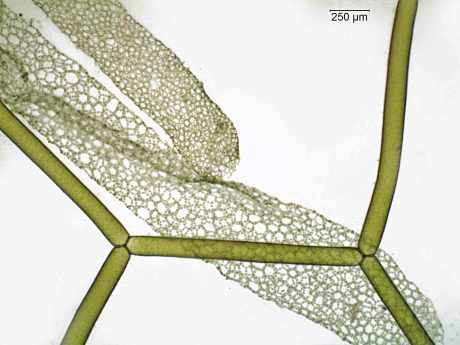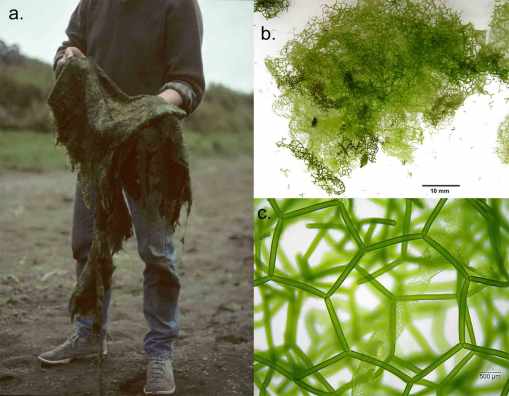A month or so ago I wrote a couple of posts about the green algae that were thriving in the River Wear this summer (see “Keeping the cogs turning …” and “More green algae from the River Wear”). In one of those, I promised to write a post about a related genus, Hydrodictyon. I did try to find some recent populations but ran out of time so have fallen back on some old pictures along with more of Chris Carter’s spectacular photography.
Hydrodictyon reticulatum is commonly called the “water net” and can form extensive, and sometimes nuisance, growths, either floating in a lake or a slow-flowing river, or as a mat at the edge (see photos below). The cylindrical cells are arranged in pentagons or hexagons which can be visible with the naked eye (hence the net-like appearance). These have a mode of asexual reproduction that results in tiny zoospores being formed inside each cell. Each of these develops into a small daughter cell whilst still inside the mother cell, and the ends of these daughters then join together to form mini-nets. You can see this happening in Chris’ image at the top of the post: there are some young cells in the foreground with a mature “mother” cell full of “daughter” cells forming their own nets inside. Eventually, the wall of the mother-cell disintegrates and the daughter net is released.
A mat of Hydrodictyon reticulatum from the lower River Tweed; b. macro, and, c. microscopic views of coenobia of H. reticulatum from Thrapston Lake, Northampton (b. and c. by Chris Carter).
This is an extremely effective way of enabling Hydrodictyon reticulatum to spread quickly when conditions favour its growth and the image below shows just how extensive these mats can be. It is a species that is more common in the warmer parts of the world but it does occur in the UK as far north as Scotland and Brian Whitton has predicted that it is a species that is likely to be favoured in some climate warning scenarios. Some authors have suggested that Hydrodictyon favours nutrient-rich water, but some of the locations where I have found it (the River Tweed in Scotland, Sunbiggin Tarn in Cumbria) do not meet this criterion. Rather, I suggest that well-lit, relatively undisturbed summer conditions are the key factor and that this is more likely to be the case in lowland areas that are, in many cases, also rich in nutrients. It is more likely to be a correlation than a cause, in other words. Whatever the cause, there is a huge dichotomy between the beauty of the organism under the microscope and the nuisance that it can cause.
A huge growth of Hydrodictyon reticulatum at Manor Farm Weir on the Jubilee River (a flood alleviation channel of the River Thames near Maidenhead). Photo: Environment Agency.
This mode of asexual reproduction – in which the zoospores aggregate inside the parent – is also a feature of Pediastrum. Even though the shapes and dimensions of the organisms are very different, they share some fundamental properties. Molecular phylogenetic studies have also shown that there is a close affinity between Hydrodictyon, Pediastrum and the other genera I mentioned in “Keeping the cogs turning …”. However, their habits and ecology are very different and that raises some interesting questions about a different matter entirely … the subject of my next post.
Reference
John, D.M., Pentecost, A. & Whitton B.A. (2001). Terrestrial and freshwater eukaryotic algae. pp. 148-149. In: The Changing Wildlife of Great Britain and Ireland (edited by D.L. Hawksworth). Taylor & Francis, London.
Krienitz, L. & Bock, C. (2012). Present state of the systematics of planktonic coccoid green algae of inland waters. Hydrobiologia 698: 295-326.



